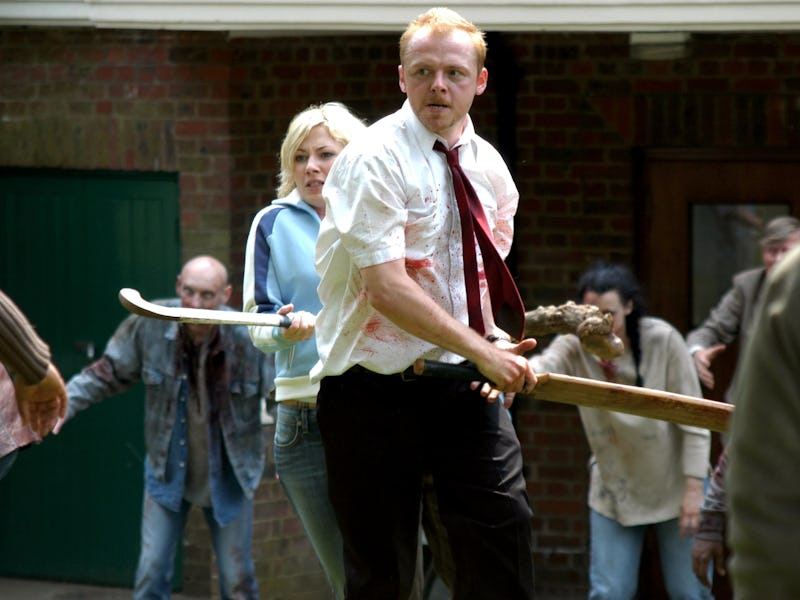Decades Later, Shaun of the Dead Still Feels Revolutionary
The apocalypse has never been funnier.

Zombies are one of the most malleable fictional metaphors. The flesh-eating carnage they create makes the mortal stakes of their stories obvious. But most zombie stories actually soften our concerns about fatalities; the worst-case scenario isn’t the end of life, but the idea that you’re transformed into a mindless monster. That’s where the deeper significance of zombie stories can really land. Don’t our quotidian actions already make us all zombies?
Before zombies start appearing in Shaun of the Dead, director Edgar Wright shows us how ordinary people already look like them, including lovable loser Shaun (Simon Pegg). Shaun’s movements are decidedly zombie-ish when he staggers out of bed, making the film’s text and subtext clear from the jump: zombies are both real and metaphorical. Twenty years after its September 24, 2004, American release, Shaun of the Dead remains a classic, not because it’s a funny horror movie, but because it effectively destroyed the zombie genre with mockery.
A Zombie movie without a genre
One of Shaun of the Dead’s greatest triumphs is that, even 20 years later, its manic tonal shifts seem revelatory. The movie begins as a slacker comedy in which Shaun (Simon Pegg) is confronted with the fact that his girlfriend Liz (Kate Ashfield) is tired of going to the same pub over and over again, and wants to see him grow up. Meanwhile, Shaun’s somewhat successful roommate, Pete (Peter Serafinowicz), berates him about his squatter best friend, Ed (Nick Frost), who does nothing but sit around playing video games all day while contributing nothing to their shared flat. Shaun has a dead-end job selling TVs, where his teenage underlings mock him. His stepfather, Phil (Bill Nighy), harasses him into being a better son, while his mother, Barbara (Penelope Wilton), is oblivious to his slide into mediocrity.
Shaun’s low-stakes world is coming apart, and then the stakes become massive. After Liz dumps him, Shaun retreats into video games and slackerdom with Ed, which insulates them from paying attention to the headlines; a mysterious virus has hit London, and people are turning into zombies. This central premise is rooted in the movie’s early aughts reality, when it was still possible to stare at a screen all day and not learn what was happening in the world. Instead of Shaun and Ed facing criticism for not being connected to reality, their analog videogame habits are what save the day.
So for the first 15 minutes or so, you’re watching what’s essentially a big-screen remake of Pegg, Wright, and Jessica Stevenson’s groundbreaking 1999-2001 sitcom Spaced. Then the zombies appear.
Shaun of the Dead’s origins
The cast of Shaun of the Dead.
For fans of vintage Pegg, Edgar Wright, and their frequent collaborators, Spaced is patient zero for Shaun of the Dead and the duo’s subsequent films, including Hot Fuzz (2007) and The World’s End (2013). Shaun of the Dead is seen as the first entry in a loose trilogy, but its true origins — aside from the obvious zombie movie influences — derive from a Spaced episode called “Art,” in which Pegg’s slacker character Tim spends most of the episode playing Resident Evil 2 while imagining several characters as zombies.
Shaun of the Dead also pulls from much of the era’s British comedy talent, including prominent roles from Dylan Moran, the hilarious star of the cult sitcom Black Books, and appearances from original stars of The Office, Martin Freeman and Lucy Davis (essentially the first Jim and Pam). Pegg’s Spaced partner Jessica Stevenson also appears, metafictionally playing Shaun’s ex-girlfriend Yvonne, while Bill Nighy brings hilarious gravitas to the proceedings, making Shaun of the Dead a who’s who of 2004.
Unapologetically geeky
Simon Pegg and Nick Frost embrace slackerdom.
Outside of its origins and later influence, Shaun’s biggest impact was the way it wore its overt geekiness on its sleeve. Kevin Smith’s 1994 film Clerks is an earlier and dorkier example, but Shaun of the Dead had the audacity to employ geeky dialogue — complete with constant references to video games — while making a legitimate horror movie at the same time. The success of this approach is obvious; Shaun of the Dead didn’t just appeal to hardcore zombie movie fans who caught all the references, but reached a wider, hitherto untapped demographic. It was a deeply British film, but the comedy and geek ethos allowed it to become a mainstream hit, grossing over 38 million dollars against a tiny budget of $6 million.
You can’t imagine Edgar Wright’s 2010 Scott Pilgrim vs. the World without Shaun of the Dead coming first, or even Wright’s less comedic efforts like 2021’s Last Night in Soho, another film that remixes classic horror tropes with a stylish metafictional story. While it seems unlikely that Pegg or Wright could completely transform an entire genre again, it’s also fine if it doesn’t happen. Shaun of the Dead is like the debut album that made a rock band famous but was never really topped. When you watch it today, it becomes apparent that, if this was Pegg and Wright’s peak, that’s one impressive accomplishment.